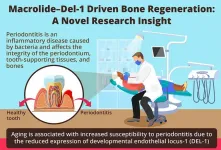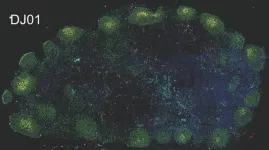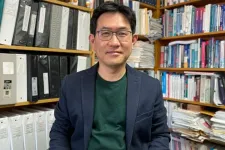(Press-News.org) A Rutgers Health analysis of millions of Medicare records has laid the groundwork for improving end-of-life care by demonstrating that nearly all older Americans follow one of nine trajectories in their last three years of life.
“Identifying which paths people actually take is a necessary precursor to identifying which factors send different people down different paths and designing interventions that send more people down whatever path is right for them,” said Olga Jarrín, the Hunterdon Professor of Nursing Research at Rutgers and corresponding author of the study published in BMC Geriatrics.
The team pulled the final three years of clinical records from a randomly selected 10 percent of all 2 million Medicare beneficiaries who died in 2018. Analysis of how much personal care each patient received and where they received care revealed three major care clusters – home, skilled home care and institutional care. Each cluster contains three distinct trajectories.
Roughly 59 percent of patients fell into the “home” cluster, meaning they spent most of their last three years at home while friends and family helped them with any tasks they couldn’t do for themselves. Such patients typically received little professional care, either in their own homes or in nursing homes, until the last year of life.
Another 27 percent of patients fell into the “skilled home care” cluster, meaning nurses and other skilled professionals helped friends and family care for them inside their own homes for most of their final three years.
The final 14 percent of patients fell in the “institutional care” cluster and spent most of their final three years either in hospitals or (more commonly) nursing homes, receiving nearly all necessary care from paid professionals.
The researchers used a group-based trajectory modeling approach, evaluating associations between care trajectories and both sociodemographic and health-related metrics. Patients in both the skilled home care and institutional care clusters were more likely than patients in the home cluster to be female, Black, enrolled in Medicaid or suffering from dementia. Extensive use of skilled home care was more prevalent in Southern states, while extensive use of institutional care was more common in Midwestern states.
“Our study not only identifies different patterns of care but also sheds light on the clinical and policy factors that dictate where and when patients receive care,” said Haiqun Lin, lead author of the study and a professor of biostatistics who is also co-director of the Center for Health Equity and Systems Research within Rutgers School of Nursing. “Understanding these patterns is crucial for advance care planning, and ultimately, for achieving the triple aim of improving care experiences, reducing care costs, and improving care quality.”
The study is the first of several the researchers plan to base on their analysis of the Medicare data. Now that they have identified the trajectories that people actually follow in their last years of life, they will look for the key factors that direct people down each path and interventions that will help more people stick to the path they prefer.
For most but not all people, that means one of the paths in the home cluster.
“Most people want to stay at home with minimal professional help,” said Jarrín, who also is the director of the Community Health and Aging Outcomes Laboratory within Rutgers Institute for Health, Health Care Policy, and Aging Research. “However, the goal for a significant minority of people is to avoid being a burden to family and friends, and such people tend to want professional care.”
Jarrín added: “Our goal isn’t forcing people toward any particular type of care. It’s helping them to plan for and get the care that’s right for them.”
This research was supported by the National Institutes of Health’s National Institute on Aging, grants R33AG068931 and R01AG066139.
END
A study of how Americans die may improve their end of life
2024-01-25
ELSE PRESS RELEASES FROM THIS DATE:
Novel macrolide–DEL-1 axis drives bone regeneration in aging individuals
2024-01-25
Niigata, Japan - Scientists from Niigata University discover macrolide-based molecules that increase the expression of DEL-1 protein and help in bone regeneration
Periodontitis is characterized by the loss of teeth resulting from inflammation of gums due to bacterial infections. The susceptibility to such bone loss disorders increases with age. The expression of the developmental endothelial locus-1 protein, crucial for bone regeneration, declines with age. Recently, researchers from Niigata University, University of Pennsylvania team identified ...
Cold water swimming improves menopause symptoms
2024-01-25
Menopausal women who regularly swim in cold water report significant improvements to their physical and mental symptoms, finds a new study led by UCL researchers.
The research, published in Post Reproductive Health, surveyed 1114 women, 785 of which were going through the menopause, to examine the effects of cold water swimming on their health and wellbeing.
The findings showed that menopausal women experienced a significant improvement in anxiety (as reported by 46.9% of the women), mood swings (34.5%), ...
Furry fruit improves mental health – fast
2024-01-25
Kiwifruit has proven itself as a powerful mood booster and new research from the University of Otago has shown just how fast its effects can be.
In a study, published in The British Journal of Nutrition, researchers found the furry fruit improved vitality and mood in as little as four days.
Co-author Professor Tamlin Conner, of the Department of Psychology, says the findings provide a tangible and accessible way for people to support their mental well-being.
“It’s great for people ...
Women and people of color remain “invisible” as most people pick white men as their heroes, study shows
2024-01-24
Women and people of colour remain invisible to many people in Britain and the USA as people pick white men as their heroes instead, a study shows. Their achievements are often forgotten or not recognised when people are choosing who inspires them, researchers have found.
Most people said their family and friends, people closest to them, were their heroes. These ‘everyday’ heroes accounted for one in three choices in Britian and 41 per cent in the US.
In both countries, politicians were popular as heroes, with more common choices including Ronald Reagan, Abraham Lincoln, ...
Texas Biomed researchers pinpoint most likely source of HIV rebound infection
2024-01-24
In findings that have implications for potential new HIV therapies, researchers from Texas Biomedical Research Institute (Texas Biomed) used genetic sequencing techniques on the nonhuman primate version of the virus to identify that lymph nodes in the abdomen are the leading source of rebound infection after the first week of stopping antiretroviral treatment.
The study regarding simian immunodeficiency virus (SIV) was reported in the journal Science Translational Medicine. SIV is very closely related to HIV and is commonly used as a proxy to study HIV in animal models.
“Lymphoid tissues are known to be large ...
Microplastics may be accumulating rapidly in endangered Galápagos penguins’ food web
2024-01-24
Microplastics, with a size from 1 micron to < 5 millimeters, are pervasive pollutants that have been found in all parts of the global ocean, and have made their way into the marine food webs. Researchers, led by University of British Columbia UBC’s Institute for the Oceans and Fisheries scientists and Ecuadorian researchers from Galápagos and the ESPOL Polytechnic School (Guayaquil, Ecuador), looked closely at how microplastic bioaccumulation was affecting the endangered Galápagos penguin (Spheniscus mendiculus) as an indicator species to trace how deeply microplastic bioaccumulation has entered the food web in the isolated Galápagos Islands.
An ...
The more the merrier: Research shows online interventions with social support help middle-aged adults with obesity lose weight
2024-01-24
Obesity is a problem in the United States. In fact, 42.5% of U.S. adults aged 20 and over have the disease. Not only is obesity the nation’s second leading cause of preventable death (behind only smoking cigarettes), it also leads to other serious health issues, including an increased risk of type 2 diabetes, high blood pressure, heart disease, stroke, cancer, sleep apnea and liver disease. The disease and its side effects impose a significant financial burden on America’s health care system.
As many make — and often fail to keep — New Year’s resolutions about exercise and weight loss goals, University ...
Salk Institute Professor Ronald Evans honored with Japan Prize
2024-01-24
LA JOLLA (January 22, 2024)—Salk Professor Ronald Evans has been named the 2024 recipient of the Japan Prize in the field of Medical Science and Pharmaceutical Science. The Japan Prize Foundation awards this prestigious international award annually to “express Japan’s gratitude to international society.”
"I am delighted to extend my congratulations to Ron for this well-deserved recognition in honor of his discovery of nuclear hormone receptors,” says Salk President Gerald Joyce. “This accomplishment not only reflects the exceptional caliber of Ron’s research ...
How does HIV get into the cell’s centre to kickstart infection?
2024-01-24
UNSW medical researcher Dr David Jacques and his team have discovered how the human immunodeficiency virus (HIV) breaches the cell nucleus to establish infection, a finding that has implications beyond HIV biology.
To infect cells, HIV must enter the target cell and make its way to the nucleus in the cell’s centre where enough copies of its genetic code can be produced to infect other cells.
To safely complete this quest, the virus builds a protective protein coat – a capsid – to shield itself from the host’s immune defences geared to destroy it. Until ...
One in five Colorado bumblebees are endangered, new report says
2024-01-24
On a cliffside at Mesa Verde National Park in southern Colorado, a fuzzy bee was industriously gnawing at the red sandstone. Making a loud grinding sound, the insect used its powerful jaws to drill tunnels and holes in rocks, where it would build a nest for raising offspring.
The bee, known as Anthophora pueblo, is a type of digger bee native to Colorado. Discovered less than a decade ago, the bee has quickly become Adrian Carper’s favorite pollinator.
“This is just one example of how crazily diverse our native bees are,” said Carper, an ...





